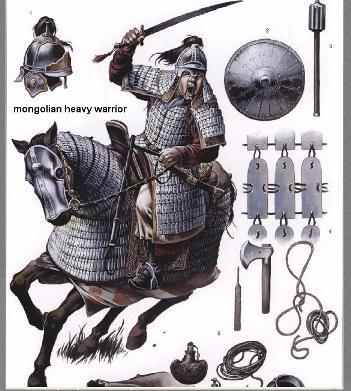
Warrior armor.
Most Mongol warriors fought as light horsemen, wearing leather body armor and, if possible, a silk undershirt—allegedly offering protection against an arrow shot. Their minority of heavy cavalry, however, were sometimes equipped with Chinese-style metal armor. Made of overlapping plates, usually sown onto a backing garment, this is a replica of a Mongol armor that was flexible and offered good protection in close combat.
The Mongols were famous for their mastery of firing their arrows in any direction while mounted and galloping at full speed. Strapped to their backs, their quivers contained 60 arrows and two bows made of bamboo, sinew, and yak horn. These composite reflex bows were first glued together and then bound in such a way that they set into a solid, extremely strong and durable piece. The bow was strung against its natural curve, which gave an exceptionally strong pull and enabled the archer to deliver a very accurate and deadly shot. The bow had a pull of 166 pounds and a destructive range of between 200 and 300 yards. A mounted archer would keep two or three bows accessible in a large protective bow case along with quivers containing 30 arrows with an assortment of arrowheads. The arrowheads were hardened by first heating over fire and then plunging the red-hot metal into brine. Such arrows were capable of piercing armor. Sometimes poison was added to the arrows. Eagle feathers were used for the fletching and could be made to whistle if needed for signaling purposes.
In hand-to-hand combat the soldier’s best protection was the shield. It was usually small, round, and made of wood, osier, or wicker. It had to be light enough for the fighter to also wield his saber-shaped sword and ax. Carpini claimed that the shields were only employed by camp guards. Spears and maces of various designs, shapes, and weights would also be employed. If carrying and also using these weapons was not enough, the Mongol warrior was also weighed down with a lasso, a file, an iron cooking pot, two leather bottles, and a leather bag to keep equipment and clothes dry when crossing rivers. A tent, shared by 10 men, also had to be carried.
The light cavalry were armed with a small sword and two or three javelins, whereas the heavy horsemen carried a long lance (4 meters) fitted with a hook, a heavy mace or ax, and a scimitar (an oriental sword with a curved blade broadening toward the point). The hooks on the lance were used to drag an opponent from his horse.
The Franciscan Friar Giovanni DiPlano Carpini (1180-1264) traveled to the court of the Great Khan Gliylik between 1245 and 1247 as a representative of the Pope Innocent IV. He was essentially a spy, though an extremely unlikely candidate at well over 60 years old and somewhat obese. He had knowledge of languages other than Latin, however, and as a friar he had experience with dealing with both the high and mighty and with the common rabble. His brief was to find out as much as possible about the dreaded Tatars, and this he succeeded in admirably. His report is particularly interesting where he reports on military matters. The following extract concerns soldiers’ weapons.
Everyone must have at least these weapons: two or three bows or at least one good one, and three large quivers filled with arrows, a battle-axe and ropes for dragging machines. The rich, however, have swords which are sharp at the tip and honed on only one edge and somewhat curved, and they have horse armor, leg armor and a helmet and cuirass. Their cuirasses and horse armors are of leather and made this way: they take strips of cowhide or other animal hide of one hand’s width wide, and they glue three or four of these together and tie them to each other with laces or cords. In the top strip they put the cords at the edge, in the one below they put them in the center and they do this until the end. Therefore, when the soldiers bend, the lower strips slide up over the upper ones and so they are doubled or even tripled over the body.
The Tartars make horse armor in five parts: they put one piece along each side of the horse which protects it from the tail to the head and is tied to the saddle, behind the saddle on the back, and at the neck. Over the horse’s back they put another piece where the two parts of the harness are joined and the}^ make a hole in this piece through which they expose the tail, while in front of the chest they place a piece that protects everything from the knees or the knee joints. On the forehead they put an iron plate which is tied on each side of the neck.
On campaign all fighting men were expected to carry their equipment and provisions as well as their weaponry. A horsehair lasso, a coil of stout rope, an awl, needle and thread, cooking pots, leather water bottles, and a file for sharpening arrows would be among the utilities possibly carried in an inflatable saddlebag fashioned from a cow’s stomach. When fording rivers, this saddlebag, if inflated, could double as a float.
When not on campaign life was not so very different. War simply entailed some modifications to the Mongols’ daily life. As nomads, the Mongols continued to practice seasonal migration from the open plains of summer to the sheltered valleys of the winter months. Distances were not great, with a typical route encompassing 100 miles. To adapt to a war footing would not necessarily have to entail a great change in routine, though careful planning and preparation would be an essential part of such military migration.